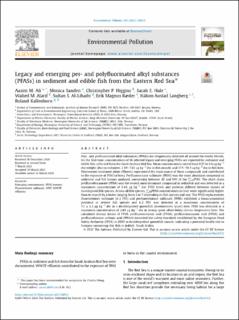| dc.description.abstract | Poly and perfluorinated alkyl substances (PFASs) are ubiquitously detected all around the world. Herein, for the first time, concentrations of 16 selected legacy and emerging PFASs are reported for sediment and edible fish collected from the Saudi Arabian Red Sea. Mean concentrations varied from 0.57 to 2.6 μg kg−1 dry weight (dw) in sediment, 3.89–7.63 μg kg−1 dw in fish muscle, and 17.9–58.5 μg kg−1 dw in fish liver. Wastewater treatment plant effluents represented the main source of these compounds and contributed to the exposure of PFAS to biota. Perfluorooctane sulfonate (PFOS) was the most abundant compound in sediment and fish tissues analysed, comprising between 42 and 99% of the ∑16PFAS. The short chain perfluorobutanoate (PFBA) was the second most dominant compound in sediment and was detected at a maximum concentration of 0.64 μg kg−1 dw. PFAS levels and patterns differed between tissues of investigated fish species. Across all fish species, ∑16PFAS concentrations in liver were significantly higher than in muscle by a factor ranging from 3 to 7 depending on fish species and size. The PFOS replacements fluorotelomer sulfonate (6:2 FTS) and perfluorobutane sulfonate (PFBS) exhibited a bioaccumulation potential in several fish species and 6:2 FTS, was detected at a maximum concentration of 7.1 ± 3.3 μg kg−1 dw in a doublespotted queenfish (Scomberoides lysan) liver. PFBS was detected at a maximum concentration of 2.65 μg kg−1 dw in strong spine silver-biddy (Gerres longirostris) liver. The calculated dietary intake of PFOS, perfluorooctanoic acid (PFOA), perfluorononanoic acid (PFNA) and perfluorohexane sulfonic acid (PFHxS) exceeded the safety threshold established by the European Food Safety Authority (EFSA) in 2020 in doublespotted queenfish muscle, indicating a potential health risk to humans consuming this fish in Jeddah, Saudi Arabia. | en_US |
